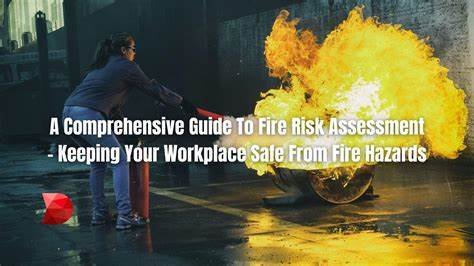Fire safety is a crucial aspect of maintaining a safe and secure workplace. A Fire Risk Assessment (FRA) is a systematic process used to identify and manage fire hazards, ensuring the safety of employees, visitors, and the physical premises. By conducting a thorough FRA, employers can proactively prevent fires and mitigate the potential consequences. Here is a step-by-step guide to help you conduct a comprehensive fire risk assessment in your workplace.
Step 1: Identify Fire Hazards
The first step in the fire risk assessment process is identifying potential fire hazards in your workplace. A fire hazard is anything that has the potential to cause a fire or contribute to its spread. Common fire hazards in workplaces include:
- Flammable materials: Chemicals, gases, oils, cleaning supplies, or paper.
- Heat sources: Heating systems, machinery, electrical equipment, and open flames.
- Electrical hazards: Faulty wiring, overloaded circuits, or exposed electrical outlets.
- Smoking areas: Any designated smoking zones or improper disposal of cigarette butts.
Take time to walk through the entire workplace, paying special attention to areas like kitchens, storage rooms, and areas with heavy machinery. Document any potential fire hazards you find.
Step 2: Identify People at Risk
Next, assess who might be at risk in the event of a fire. This includes both employees and visitors, especially those who might face specific risks. Key groups to consider are:
- Employees working in high-risk areas such as factories, kitchens, or areas with dangerous equipment.
- Employees with disabilities who may need assistance during evacuation.
- Visitors who may not be familiar with the building’s evacuation procedures.
- Contractors or temporary workers who may be unaware of existing safety protocols.
Also, consider areas where people may be less likely to notice a fire or evacuate quickly, such as isolated offices, basements, or storage rooms.
Step 3: Evaluate the Risks
Once hazards and people at risk have been identified, it’s time to evaluate the level of risk each fire hazard presents. For each hazard, ask:
- How likely is it that the fire hazard could lead to a fire?
- If a fire occurred, what would be the potential impact on people, property, and the environment?
- Could the fire spread quickly due to the presence of flammable materials or poor ventilation?
Use a simple risk matrix to assess each hazard in terms of its likelihood and severity. This will help prioritize which risks need to be addressed immediately and which ones can be monitored over time.
Step 4: Control and Mitigate Risks
Once the risks have been evaluated, the next step is to reduce or eliminate them. This involves implementing control measures that either remove the hazard entirely or minimize its potential to cause harm. Some strategies include:
- Eliminating flammable materials: Replace dangerous chemicals or materials with safer alternatives.
- Improving ventilation: Ensure areas with heat-producing equipment are properly ventilated to prevent heat buildup.
- Regular maintenance of electrical equipment: Have electrical systems inspected regularly to prevent faults that could lead to fires.
- Training staff: Teach employees about fire prevention, safe use of equipment, and evacuation procedures.
- Providing fire extinguishers: Ensure fire extinguishers are available, accessible, and properly maintained.
Additionally, make sure that there are clear, unblocked escape routes and that fire exits are properly marked and easy to access.
Step 5: Prepare Emergency Procedures
After mitigating risks, establish and document comprehensive fire safety procedures. This should include:
- Evacuation plans: Clear and concise procedures for evacuating the building, with designated roles for staff (e.g., fire wardens).
- Assembly points: Safe areas where employees and visitors can gather after evacuation to ensure everyone is accounted for.
- Fire drills: Regular fire drills should be conducted to practice the procedures and ensure everyone knows what to do in case of a fire.
- Emergency contacts: A list of emergency services (fire department, building managers) should be readily available.
Ensure all employees are familiar with these procedures, and display fire safety information prominently throughout the workplace.
Step 6: Monitor and Review the Risk Assessment
Fire risk assessments are not a one-time task; they should be regularly reviewed and updated. Changes in the workplace—such as new equipment, materials, or personnel—can introduce new fire hazards. Regular monitoring helps to:
- Ensure the control measures remain effective.
- Address new risks that may arise.
- Ensure employees continue to follow fire safety procedures.
It’s also important to keep records of the fire risk assessment and any steps taken to mitigate risks. Regular reviews, ideally every year or when there are significant changes, help maintain a high standard of fire safety.
Conclusion
Conducting a fire risk assessment is a critical responsibility for every employer. By systematically identifying hazards, evaluating risks, implementing control measures, preparing emergency procedures, and continuously monitoring safety practices, you create a safer environment for everyone in your workplace. Fire safety is not only about compliance with regulations but also about ensuring the well-being of your employees and safeguarding the business against potential fire damage. A proactive approach can prevent devastating consequences and help maintain a safe, productive workplace.

